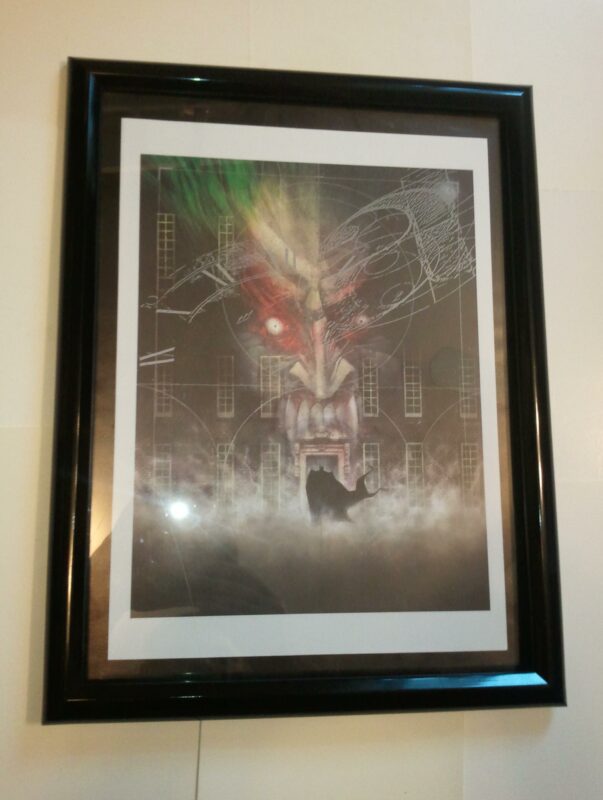Batman Poster #34 FRAMED Arkham Asylum Anniversary Edition (2005) Dave McKean
$84.99
Description
You are purchasing the item pictured, framed. Priority mail, tracking and $50 insurance is included with purchase. Item will be bagged to protect from dust, packed in packing peanuts and boxed. Just open box and hang it on the wall…makes a perfect gift!
Love it or hate it, you couldn’t ignore Grant Morrison and Dave McKean’s graphic novel Arkham Asylum in the summer of 1989. Published just in time to capitalize on the box-office success of Tim Burton’s first Batman feature, the macabre tale saw Gotham’s villainous madhouse inhabitants tenebrously brought to life by McKean in 120 painted pages. Heavily laden with psychological symbolism and obscure literary references, Arkham Asylum in form and contect was unlike any Batman story ever produced up to that point. The books style alienated some readers but not nearly enough to keep it from becoming one of the best-selling graphic novels of all time. To date, it has sold more than half a million copies and counting. “What Dave and I wanted to do with Arkham was use Batman in a completely symbolic way, to say this isn’t man at all, he’s about an aggregation of ideas, which is why Dave painted it in a ghostly style with Batman as an almost spiritual force.”- Grant Morrison. The Elizabeth Arkham Asylum for the Criminally Insane, commonly called Arkham Asylum, is a psychiatric hospital in the DC Universe, usually appearing in stories featuring Batman. Many psychotic criminals from across the DC Universe, mostly from Batman’s own rogues gallery (such as The Joker, Poison Ivy, The Riddler, Two-Face, the Scarecrow, Bane, Killer Croc, and Harley Quinn) have been imprisoned within the Asylum and also escaped from it. The Arkham Asylum is named after the Sanatorium in the fictional city of Arkham, Massachusetts, found in many of H.P. Lovecraft’s short horror and science fiction stories, such as “The Colour out of Space”. Arkham Asylum: A Serious House on Serious Earth (often shortened to Batman: Arkham Asylum) is a Batman graphic novel written by Grant Morrison and illustrated by Dave McKean. It was originally published in the United States in both hardcover and softcover editions by DC Comics in 1989. The subtitle is taken from line 55 of the Philip Larkin poem “Church Going.” In his original script printed in the 15th Anniversary Edition (2004), Morrison remarks on several details behind the genesis of the work: “Len Wein… had written a few short and evocative paragraphs on the history of Arkham Asylum in the DC Who’s Who series and it was here I learned of poor Amadeus Arkham, the hospital’s founder…. Arkham’s themes were inspired by Lewis Carroll, quantum physics, Jung, and Crowley; its visual style by surrealism, Cocteau, Artaud, Svankmajer, the Brothers Quay, etc. The intention was to create something that was more like a piece of music or an experimental film than a typical adventure comic book. I wanted to approach Batman from the point of view of the dreamlike, emotional and irrational hemisphere, as a response to the very literal, ‘realistic’, ‘left brain’ treatment of superheroes which was in vogue at the time, in the wake of The Dark Knight Returns, Watchmen, and others.” An additional reference to the work as a “response” to trends of the time is made in a later note: “The repressed, armored, uncertain and sexually frozen Batman in Arkham Asylum was intended as a critique of the ’80s interpretation of Batman as violent, driven, and borderline psychopathic.” Morrison goes on to explain that this conception of the character is for this book alone, and that his other work involving Batman has cast him in a far different (and more positive) light. He explains, “… the story is woven tightly around a small number of symbolic elements, which combine and recombine throughout, as if in a dream: the Moon, the Shadow, the Mirror, the Tower, and the Mother’s Son. The construction of the story was influenced by the architecture of a house — the past and the tale of Amadeus Arkham forms the basement levels. Secret passages connect ideas and segments of the book. There are upper stories of unfolding symbol and metaphor. We were also referencing sacred geometry, and the plan of the Arkham House was based on the Glastonbury Abbey and Chartres Cathedral. The journey through the book is like moving through the floors of the house itself. The house and the head are one.” Hilary Goldstein of IGN Comics said that “Arkham Asylum is unlike any other Batman book you’ve ever read and one of the finest superhero books to ever grace a bookshelf.” Goldstein ranked Arkham Asylum #4 on a list of the 25 greatest Batman graphic novels, behind The Killing Joke, The Dark Knight Returns, and Year One. Arkham Asylum illustrator Dave McKean later said he was “trying to make the book despite the subject, rather than because of it. At the end of the day, if you really love to do Batman comics, then that’s probably the best thing to do. Not liking them, and then trying to make something out of them is just a waste of time.” He also came to think that “overpainted, lavish illustrations in every panel just didn’t work. It hampers the storytelling.” Arkham Asylum was referenced in the 2008 film The Dark Knight, although actor Heath Ledger used Batman: The Killing Joke and the character’s first comic appearance as primary references for his portrayal of the Joker. The game Batman: Arkham Asylum is loosely based on the comic, following a similar premise and featuring several similar episodes, such as the fight with Killer Croc. Additionally, the new warden of Arkham, Quincy Sharp, believes himself to be the reincarnation of Amadeus Arkham, and makes frequent reference to the history outlined in the comic. The asylum founder Amadeus Arkham’s spirit haunts the mansion (however it turns out to be Warden Quincy Sharp who believes Amadeus’s spirit chose him to continue his work in cleansing the city), with the cell in which he inscribed his name in the floor also discoverable. At one point in the game, Quincy Sharp calls the Joker “filthy degenerate”, just as Batman does in the graphic novel. Additionally in the beginning of the game The Joker says to Batman that he is “always welcome” in Arkham. David McKean (born 29 December 1963 in Maidenhead, Berkshire) is an English illustrator, photographer, comic book artist, graphic designer, filmmaker and musician. His work incorporates drawing, painting, photography, collage, found objects, digital art and sculpture. McKean’s most recent projects are directing an original feature called Luna, and a book with the evolutionary biologist Richard Dawkins. In 1989, he illustrated the Batman graphic novel, Arkham Asylum: A Serious House on Serious Earth, with writer Grant Morrison. His work during this period was often compared to that of Bill Sienkiewicz. From 1989–1996 McKean produced the covers for Gaiman’s celebrated series The Sandman, all its collected editions, and many of its spin-offs. Further collaborations with Gaiman produced the graphic novels Signal to Noise in 1992 (previously serialized in The Face magazine), about a dying filmmaker and his hypothetical last film; and Mr. Punch, which explored similar themes as Violent Cases through the imagery of the Punch and Judy show.
>PAN>Frame is shrinkwrapped until time of purchase. Ships boxed with packing peanuts.
THE PERFECT GIFT!
Related products
-
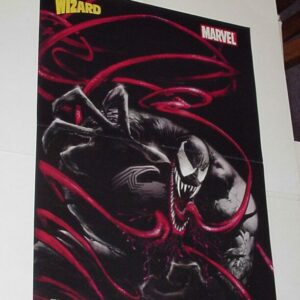
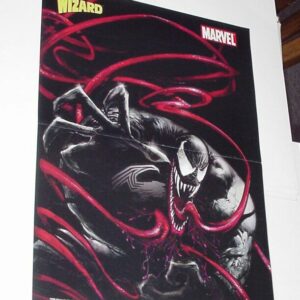
Venom Poster # 3 by Sam Kieth MTV Maxx Issue # 1 Cover
$39.99 Add to cart -
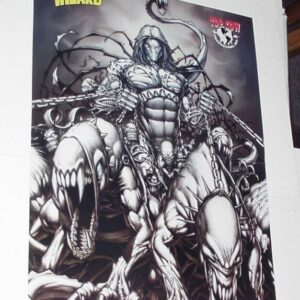
Darkness Poster # 4 Dale Keown Darklings in Chains Pitt Hulk
$29.99 Add to cart -

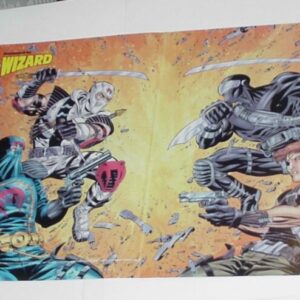
G.I. Joe Poster # 3 Cobra Commander Storm Shadow vs Snake Eyes and Billy by Mike Zeck
$34.99 Add to cart -
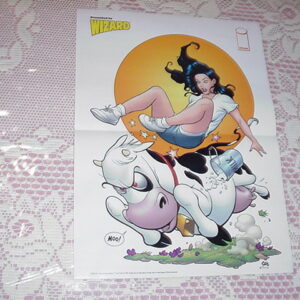
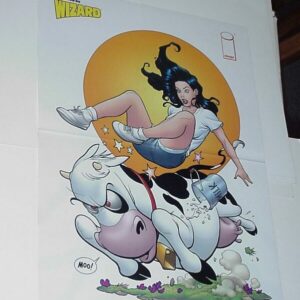
Liberty Meadows Poster # 1 The Cow vs Brandy by Frank Cho University2
$29.99 Add to cart


